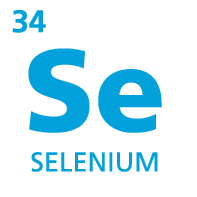Selenium Treatment for Refineries
Selenium (Se) is a heavy metal that can be harmful to human health and the environment and is a naturally occurring element that is found in crude oil. With permit levels typically in the low part per billion (ppb) range, treatment for Selenium reduction can become complex.
We work closely with our customers to deeply understand the speciation of as it travels through various refinery processes so that we can deliver the optimum solution. In our experience, refinery wastewater selenium speciation identifies selenocyanate as the predominant species in stripped sour water and selenite and selenate as the dominant species after biological treatment. We have two proven technologies for Selenium treatment, namely the FBR and AMRS processes. Contact Us today to discuss your bespoke solution. For non-Selenium related solutions, see our Petrochemical Refining page.
Significant correlations exist between changes in the levels of Selenium in refinery wastewater streams versus the type of crude being run at that time. The chemistry of Selenium reactions can require complex treatment considerations due to the speciation of Selenium into numerous compounds as it travels through various refinery processes.
Almost all incoming oil refinery Selenium enters with the crude oil. During the refining process, Selenium is released into the sour water. The sour water stripper (SWS) removes hydrogen sulfide and ammonia from sour water. However, Selenium is not removed by the SWS. The following points summarize some considerations in remediating Selenium:
- The Selenium in the crude is in the form of various organoselenides. Its chemistry resembles sulfur, so Selenium generally follows the sulfur pathways. The amount of Selenium in crude is usually proportional to sulfur at a ratio of circa. 1:1000.
- Selenium travels through various refining processes and accumulates in the sour water system.
- The bulk of organoselenides in the crude will travel with the oil phase upon passing through the desalter. The desalter wash water originating from the SWS is responsible for the Selenium contribution to the desalter effluent.
- Most of the organoselenides convert to hydrogen selenide, particularly in the hydrotreaters.
- The FCC Unit contributes significant thiocyanates (SCN-) to the sour water system. Selenium is present in FCC wastewater as elemental Selenium, selenide, and selenate. The concentration of Selenium in FCC wastewater can vary depending on the source of the crude oil and the operating conditions of the FCC unit. However, the typical concentration of Selenium in FCC wastewater ranges from 0.1 to 10 mg/L. The chemical reactions during the FCC process determine the form of Selenium present in FCC wastewater. Elemental Selenium is the most common form of selenium present in FCC wastewater. Selenide is a less common form of selenium present in FCC wastewater. Selenate is the least common form of selenium present in FCC wastewater.
- In the SWS, thiocyanates react with hydrogen selenide to create selenocyanates, the predominant species remaining in the water in the SWS bottoms. – Most unreacted hydrogen selenide in the SWS goes overhead to the sulfur recovery unit as a vapour.

Our Technologies
Fluidized Bed Reactors (FBRs) use microorganisms to remove Selenium from wastewater. Envirogen’s patented fluidized bed reactor (FBR) biological treatment technology has been proven as a ‘best in class’ approach for handling significant flow rates of selenium-containing wastewater, with low capital and operating costs, and over a wide range of influent and discharge limit conditions
Selenate and selenite ions are challenging to treat and remove as they exist in a dissolved state. To remove Selenium, precipitation is a common method that requires a large quantity of chemicals and results in high sludge production and disposal and chemical costs. One of the benefits of biological treatment is that it avoids the addition of large quantities of chemicals. Both selenate and selenite species are reduced to elemental Selenium by biological anoxic reaction in our FBR. A follow-up solid-liquid separation step removes Selenium in particulate form. Our FBR has the following features:
- The FBR technology has a long track record of providing high removal rates with a low cost of operation and “green” benefits typical of biological treatment systems.
- The advantages of employing an FBR in a selenium water treatment application include an ‘order of magnitude’ cost advantage in system design and installation compared with other commercially available technologies. This is due to smaller system footprints and the ability to manage issues such as suspended solids and waste disposal far more effectively over a broad range of influent flow rates.
- Envirogen is an industry leader in bioreactor technology, with over 200 systems installed in the United States.
- A resilient process which is highly resistant to influent fluctuations
- Operator Friendly
- Low energy consumption
- Reuse and recycling technologies made by experts to help minimize water wastage and increase sustainability
Effective selenium water treatment may be accomplished using Envirogen’s Advanced Metals Removal System (AMRS), which features Zero Valent Iron media. AMRS allows the use of multiple zero-valent iron (ZVI) media formulations to accomplish the removal of heavy metals from wastewater. Our media in this application is sulfur-modified iron, which is an extremely effective and economic media for removing a wide assortment of contaminants from water including Selenium, arsenic, nitrate, hexavalent chromium (Cr VI), vinyl chloride, trichloroethelene (TCE), chlorinated solvents, halogenated pesticides, technetium and a variety of petroleum hydrocarbons. Our solution can remove contaminants down to non-detectable levels in most applications, and also has the capability to extract rare earth minerals.
Our AMRS process can be effectively used after the sour water stripper, where Selenium is adsorbed and reduced to either elemental Selenium solid or ferrous selenide. They are both trapped in the media and disposed of as a solid when the media is changed. The effluent from our AMRS-SMI system goes to either the desalter or Central WWTP. The effluent is typically <2 ppb Selenium (Detection limit) even with a 500 ppb Selenium fee level. The treated water can be further purified and reclaimed using our other technologies as part of an enhanced water recovery reuse project.
Our proprietary AMRS design achieves up to 50% lower capital cost than conventional ZVI system designs, is effective for removing high levels of Selenium and does not produce any sludge with no toxicity impact. Our design is unlike the in-situ approach more commonly employed with conventional ZVI for metals removal from water and offers several advantages, including:
- Reduced physical footprint
- Ability to effectively operate over a range of conditions and contaminant concentrations
- Automatic pH adjustment to optimize removal efficiency
- Achieve permit compliance consistently
Our Approach
We work closely with our customers to deeply understand the problem so that we can deliver the optimum solution. We have extensive experience in refinery wastewater treatment and cannot only solve Selenium treatment issues but can also solve other wastewater and water treatment issues as well as develop reuse solutions.
Once the problem is understood, we can pilot our solutions at our laboratory or onsite to validate our solutions.
From here, we develop the optimum solution collaboratively with our customers and deliver a working solution which includes design, build and operations. Contact Us today to discuss your bespoke solution.
Download Brochure

 Selenium Treatment for Refineries
Selenium Treatment for Refineries 